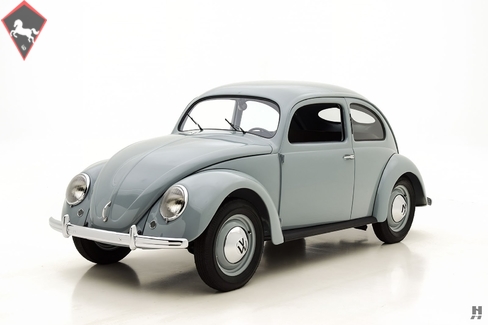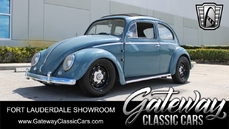Volkswagen Käfer Typ1 Sedan 1949
Allgemeine Beschreibung :
It could easily be argued that the Volkswagen Beetle (officially designated the Type 1) is the most popular and most recognizable car ever produced. Like the Ford Model T before it, the Volkswagen put a nation (and the world) on wheels thanks to its low cost and elegant mechanical simplicity. Despite its somewhat dubious roots within the Third Reich, the VW Beetle proved immensely popular in the post war years, particularly in a recovering Europe. In the US market, this funny little rear-engine car took some time to catch on, but once it did, it became immersed in popular culture, particularly through the 1960s. Many great mechanics and race car builders got their start tinkering with Beetles thanks to their simplicity, ease of service and surprising potential. A staggering 21.5 million examples were built between 1938 and 2003, becoming the longest running, highest selling, single-platform vehicle in history. From the first car to the last, changes were made not for the sake of change but always with the purpose of improvement and refinement.
1949 marked a major milestone for VW, as the year the very first Beetle was imported to the US market by the daring and brilliant Max Hoffman. Max Hoffman Imports had a bustling showroom in New York, and he was one of the most influential players in the European motoring industry, responsible for translating American tastes to European companies, along the way ensuring the success of companies like BMW, Alfa Romeo, Mercedes-Benz and Porsche established themselves in the fickle American marketplace.
While the Beetles of the 60s and 70s are most familiar to the general public, it is the cars built in the 1950s and earlier that attract the most attention from serious collectors and enthusiasts. They are considered the purest of form, and are also among the rarest given the lower production numbers and high attrition rate. True to the original design by Dr. Porsche, the shape is subtle yet complex, with form following function in a classic Teutonic manner. The earliest years of Volkswagen production were limited, with production truly gearing up after WWII was over and Germany was in recovery.
This 1949 Volkswagen Type 1 is a beautifully and recently restored example finished true to original specification. The body is outstanding, with lovely Pearl Grey paint laid down over excellent panels. Decklids fit beautifully and the doors shut solidly with excellent gaps. It has a wonderful, simple charm to it, and the paint work is expertly finished, carefully executed to not appear too glossy but with a period appropriate sheen that lends the car a factory-fresh appearance. The bumpers are excellent, as are lamp bezels on the correct Bosch lenses. Plain, painted steel wheels wear blackwall tires and simple chrome hub caps emblazoned with the VW logo. Semaphores in the B-pillars harken back to the car’s prewar roots and the distinct lack of trim and brightwork recalls the VW’s singular purpose as the car of the people.
Charming simplicity continues inside where the accommodations are about as basic as you can get, however the impeccable quality of the restoration shines through in expertly fit fabric seat upholstery and fine quality detailing front and rear. Kick panels and sills are covered in German squareweave carpet and the floors lined in fluted rubber mat. The dash is about as uncomplicated as you can get, housing a speedometer, glovebox and little else. What switchgear there is (for headlamps, wipers and turn signals) is correct. The cabin is the perfect antithesis to today’s needlessly complex automobiles that are full of distractions; this is a tool for driving, something you use to get from point to point as efficiently as possible, and yet the VW accomplishes its purpose in such an endearing way.
A correct 1131 cc horizontally opposed four cylinder sits out behind the rear axle line. The engine number (1-0135937) corresponds with both the chassis and serial numbers on the data tag and stampings in the body. The engine is carefully and properly detailed with period appropriate parts such as the brown-top Bosch coil and distributor cap, and black lacquered ignition leads. Engine sheet metal is beautifully restored and painted in a semi-gloss black as correct. It is exceptionally clean and tidy, showing almost no use since the restoration.
This is a beautifully presented Beetle; a highly desirable example from the early days of this iconic machine and a pure, simple joy to drive. This example’s fresh and immaculately prepared restoration make it immediately ready for show and enjoyment.
Offers welcome and trades considered
https://hymanltd.com/vehicles/6601
1949 Volkswagen Käfer Typ1 Sedan is listed verkauft on ClassicDigest in St. Louis by Mark Hyman for $99500.
Fakten der Auto
Karosserietyp : Auto Marke : Volkswagen Modell : Käfer Typ1 Ausführung : Sedan Hubraum : 0.0 Modelljahr : 1949 Karosstyp : Sedan Lage : Missouri
Verkauft
Angaben Zum Verkäufer
Verkauft
People who viewed this Volkswagen Käfer Typ1 also viewed similar Volkswagen listed at ClassicDigest
Other cars listed for sale by this dealer
über Volkswagen
Die Volkswagen-Geschichte ist in der Tat eine faszinierende Geschichte von Innovation, Belastbarkeit und Wiederbelebung nach dem Krieg, die von verschiedenen Modellen gekennzeichnet ist, die in der Automobilgeschichte zu Ikone geworden sind.Das Volksauto (Volkswagen): Zunächst von Adolf Hitler in den 1930er Jahren als "Volksauto" oder "Volkswagen" auf Deutsch vorgestellt, war die Idee, ein erschwingliches und praktisches Fahrzeug für das deutsche Volk zu schaffen. Dieses Konzept führte zur Entwicklung des von Ferdinand Porsche entworfenen Volkswagenkäfers (oder des Typ 1).
Nachkriegsherausforderungen: Nach dem Zweiten Weltkrieg stand Volkswagen erhebliche Herausforderungen. Die Fabrik war stark beschädigt, und die Verbindung der Marke mit dem NS -Regime führte in einigen Regionen zu einem mangelnden Interesse an dem Auto.
Britische Intervention - Die britische Armee & Ivan Hirst: Die britische Armee übernahm die Kontrolle über die Fabrik in der unmittelbaren Nachkriegszeit. Major Ivan Hirst, ein Offizier der britischen Armee, spielte eine entscheidende Rolle bei der Wiederbelebung von Volkswagen. Er erkannte das Potenzial des Käfers und setzte sich für seine Produktion ein. Er überzeugte das britische Militär, mehrere tausend Autos zu bestellen. Diese Entscheidung hat dazu beigetragen, die Wiederbelebung der Marke zu starten.
Exporterfolg und der globale Anziehungskraft des Käfers: Der Käfer gewann nicht nur in Deutschland, sondern auch weltweit an Popularität und wurde zu einer Ikone des erschwinglichen Fahrwerks. Das einfache, zuverlässige Design und das einzigartige Erscheinungsbild machten es zu einem Favoriten unter den Verbrauchern weltweit.
Modellentwicklung: Im Laufe der Jahre führte Volkswagen verschiedene Modelle neben dem Käfer ein, wobei jeder zum Wachstum der Marke beitrug:
Typ 2 (VW -Bus oder Transporter): In den 1950er Jahren wurde er in den 1960er Jahren zu einem ikonischen Symbol der Hippie -Bewegung eingeführt und wurde wegen seiner Geräumigkeit und Vielseitigkeit geliebt.
Golf (Kaninchen in den USA): Der Golf (oder Kaninchen in den USA) wurde Mitte der 1970er Jahre ins Leben gerufen und markierte eine Verlagerung in Richtung Frontantrieb, modernes Design und Schrägheckpraktikabilität und wurde zu einem Eckpfeiler des Erfolgs der Marke.
Passat, Jetta und andere Modelle: Volkswagen erweiterte seine Aufstellung mit Modellen wie dem Passat und Jetta, die sich für verschiedene Marktsegmente befassen.
Herausforderungen und Innovationen: Trotz des Erfolgs stand Volkswagen vor Herausforderungen, einschließlich Qualitätsproblemen in den 1970er Jahren. Die Marke hat jedoch weiterhin neue Modelle und Technologien entwickelt und entwickelt.
Aufstieg des GTI und globaler Expansion: In den 1980er Jahren stieg der legendäre Golf GTI auf, eine Hochleistungsversion, die den Trend der heißen Luke auslöste. Volkswagen erweiterte auch seine globale Präsenz in diesem Zeitraum.
Die britische Intervention bei der Wiederbelebung von Volkswagen nach dem Zweiten Weltkrieg spielte eine entscheidende Rolle bei der Wiederbelebung der Marke. Während es in den 1950er und 1960er Jahren aufgrund des Erfolgs von Volkswagen in den 1950er und 1960er Jahren möglicherweise einige Spannungen oder einen Wettbewerb zwischen Automobilunternehmen gegeben hat, hat die Fähigkeit der Marke, innovative und beliebte Modelle zu produzieren, ihren Platz in der Automobilgeschichte festigend.











